4 Facts About Decision Making That Will Improve Conversion Rate Optimization
by guest author Jeremy Smith Everything in conversion optimization comes down to the customer making a decision Yes or no. That’s the clutch point in conversion optimization. Leading up to this decision is the process of decision making. Everyone makes decisions. The outcome of these decisions means a conversion or not. I believe that if we can understand the psychology of decision making, we can take action that will improve our conversion rates. The thinking processes that lead customers to arrive at a decision are common enough among all people for us to identify them and act upon them. In the article that follows, I will discuss four characteristics of decision-making, and provide actionable information that can help you improve the decision-making process of people who visit your website. The result is that you will be able to improve your conversions. (The first four characteristics in this list are drawn from the book by Chip and Dan Heath, Decisive: How to Make Better Choices in Life and Work.)
Decision Making Characteristic 1: Customers usually consider few options (Narrow Framing).
In most decision-making, a person experiences the phenomenon of narrow framing. This limits their ability to consider alternative choices, and pushes them to make the first or most obvious choice with which they are confronted.
What is narrow framing?
Narrow framing happens when we don’t consider all the available options. Your choices are confined narrowly. For example, a man wants to buy a wallet. Not knowing much about the wallet industry, he thinks to himself, I must choose a brown wallet or a black wallet. What he doesn’t realize is that there are nylon wallets, leather wallets, tri-fold wallets, bi-fold wallets, money clips, wallet bands, coin holders, long wallets, cotton wallets, monogrammed wallets, designer wallets, alligator skin wallets, hipster wallets, organizer wallets, shoulder strap wallets, clasp wallets, breast wallets, travel wallets, French purses, wrist wallets, Jimi wallets, accordion wallets, and hybrid wallets. OR, the customer may not have realized that maybe he doesn’t need a wallet. Maybe he needs to place all his money and credit cards in his desk drawer, and not take them out. Or maybe he needs to use the iPhone 6 NFC for payment, or maybe he needs to take a vow of poverty, and never look upon money anymore. Or maybe he needs to wear togas, and not carry around personal accessories. Or maybe he needs to let his wife buy a wallet and carry around his monies, so he is not tempted to spend money on Harley Davidson accessories. You get the point? When we narrow-frame our choices, we experience a paucity of decisions. As I will explain below, our minds revert to the most simple and straightforward method of making a decision. We don’t consider the myriad other options of wallet purchasing. Instead, we think black or brown. Which one?
How do you we apply this information to conversion optimization?
Bid for the right keyword.
If you appear at the top of paid search results, you’ll also appear at the top of people’s minds for certain keywords or transactional search queries. Your presence in the SERPs feeds the customer’s proclivity towards narrow framing. You become one of the narrowly framed options, thus improving your chances at a conversion. If a customer is only considering the top three results in a SERP, and you’re one of them, then there is less concern that he or she will start considering wildly different options. Let’s say a customer needs CRM software. So, they search for CRM software. 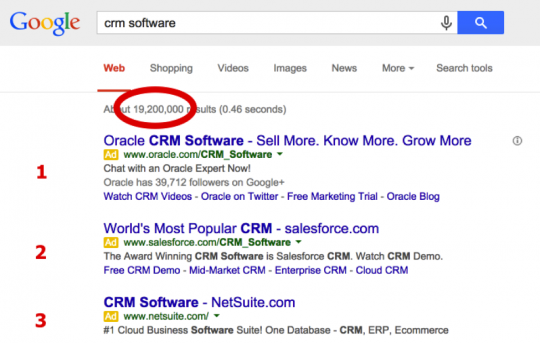 These top three PPC ads will enter into the customer’s narrow framing. I happen to know that there are dozens of CRM software options — SAP, RightNow, Sage, 8×8, McGladrey, MotherNode, Team Support, Fresh Desk, ZenDesk, SalesOutlook, PropertyBase, Hatchbucks, SalesLog!x, and on and on. However, because these top three CRM companies listed in the SERPs have deep pockets and high bids, they are able to capture the decision-making bandwidth of their target audience. You may not be competing with Salesforce, but you can be bidding on the right keywords for your specific niche. Focus on the keywords that you want, in order to capture the user’s narrow framing tendency.
These top three PPC ads will enter into the customer’s narrow framing. I happen to know that there are dozens of CRM software options — SAP, RightNow, Sage, 8×8, McGladrey, MotherNode, Team Support, Fresh Desk, ZenDesk, SalesOutlook, PropertyBase, Hatchbucks, SalesLog!x, and on and on. However, because these top three CRM companies listed in the SERPs have deep pockets and high bids, they are able to capture the decision-making bandwidth of their target audience. You may not be competing with Salesforce, but you can be bidding on the right keywords for your specific niche. Focus on the keywords that you want, in order to capture the user’s narrow framing tendency.
Don’t talk about competitors.
A customer who is narrow framing may not be considering alternatives. Don’t mess around talking about competitors and showing why you’re better. By doing so, you may be introducing cognitive friction. The customer may be thinking, “Hmm. I never heard of Awesome Widgets before. Maybe they are better. Maybe this company is telling me not to consider them, because Awesome Widgets is cheaper or awesomer. Hmm….” The narrow framing phenomenon, which had worked to your advantage before, is crumbling around you because you introduced a new options. It is appropriate, however, to bid on the keywords for a competitor’s navigational searches. For example, Hootsuite bids on “Buffer” keywords to broaden the narrow framing phenomenon of a customer who may be interested only in Buffer. 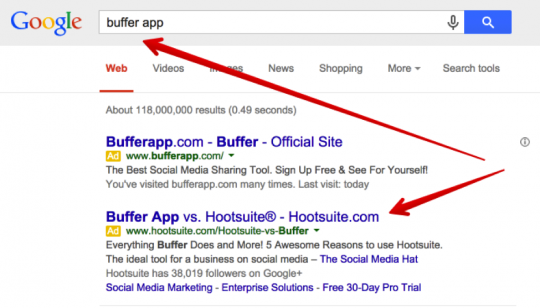
Decision Making Characteristic 2: People choose to listen to data that confirms a decision that they have already made.
This is known as confirmation bias, and it affects much of our decision making.
What is confirmation bias?
Confirmation bias happens when we only pay attention to the data or information that affirms our decision or beliefs. We interpret all new data through the grid of what we’ve already decided. There are many varieties of confirmation bias. All decision-makers are susceptible to the bias, and unconsciously affected by it. One of the most fascinating features of confirmation bias is that it causes us to press our beliefs beyond the level of credibility. Even though evidence overwhelmingly contradicts our position, we hold tenaciously to our preferred belief.

In a New York Times article on the subject, journalist Carl Richards writes regarding the confirmation bias that it is a “tendency to look for information that supports the way we feel about something…we do this all the time.”  The process is quite simple, as this diagram suggests:
The process is quite simple, as this diagram suggests:
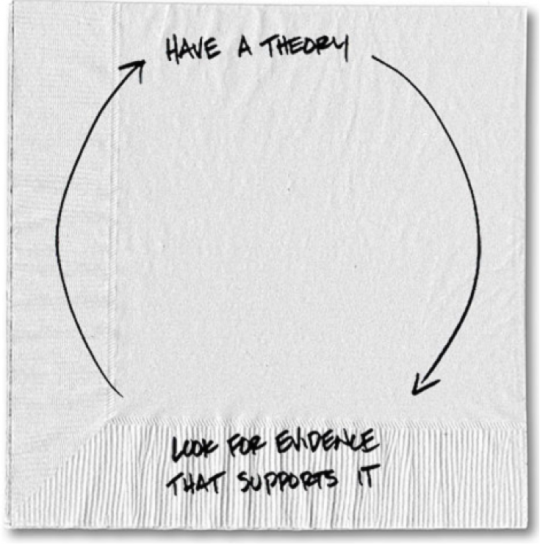
So, let’s go back to our idea of a CRM. Let’s say you choose SalesForce. But then, you see hard data from NetSuite that they are cheaper. What do you do? You think, “Well, yes, but month-over-month, the overall cost of Salesforce is probably actually cheaper. Plus, with all the limitations of NetSuite, I would probably end up paying more in terms of lost time and inconvenience. Besides, NetSuite probably has hidden costs that actually make it more expensive. No, no, I think that SalesForce is cheaper.”
How do you we apply this information to conversion optimization?
Most people have made up their mind.
Let’s face it. Many of our prospective customers have decided whether or not they will make a purchase before they see our landing page. As persuasive and as convincing as we may think we are, it is very difficult to budget a confirmation bias.
- They have decided that they will or will not buy.
- They have decided the general category of what they will buy (shirt, black wallet, etc.)
- They have decided the price point at which they will buy.
These are big challenges to confront. Rather than attack those biases, we must admit that they exist, and posture our messaging in such a way that we are agreeable, not confrontational.
Present the emotional argument first.
Confirmation bias can be overturned. But the right way to overturn it is not with pie charts, line graphs, statistics, and numbers with decimal points. Instead, we push the emotional argument. Find the emotional sweet spot of your customer. What do they want? Joy? Fulfillment? Acceptance? Relief? Euphoria? Target that approach first to dislodge their bias. Remember, people listen to what they want to hear. They want to hear what makes them happy — the information that resonates with their emotional sweet spot. The reason why people suffer from confirmation bias is because their preferred cognitive status is one of equilibrium. Intaking conflicting information requires intensive cognitive output. It is hard work, and it is disequilibrium. If you present information that is satisfactory and appealing, they will be likely to listen to it. Only after that should you present your data.
Decision Making Characteristic 3: Decisions are often made when emotions override rational thought processes.
Making a decision is an emotional process. The more difficult or intense the decision, the more emotional it is. We cannot separate emotion from the decision-making equation. But often emotions have varying degrees of impact upon a decision.
How do you we apply this information to conversion optimization?
Emotions tend to cloud the decision-making process, which can either work to our advantage or against it. Your goal in conversion optimization is to stir up emotion. Emotion is to a conversion like WD-40 on a stuck lug nut. Spray it on, and the lug nut slips off. Add some emotion to a landing page, and the customer is likely to convert. As the Harvard Business Review reported, “ strong emotional activation is the key to…success.”
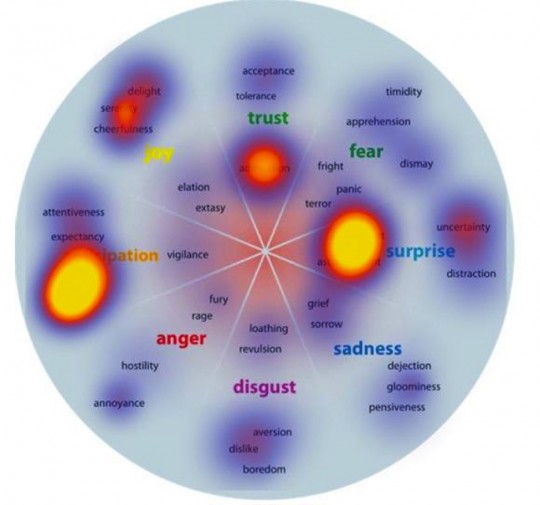
Tim Ash explains that “people don’t often make rational decisions.” In light of this, “The best way to get visitors to act is to appeal to their fundamental emotional motivations.”
Decision Making Characteristic 4: People prefer to be confident in a decision that they have just made.
We all like to feel good about our decisions. But what if we don’t feel good about a decision? We are likely to go back on that decision. In some cases, the decision is irreversible. We can’t never have gotten married or had a child. We live with those decisions. In some cases, the decision is reversible. Although we can’t undo an action, we can take back a product. (That’s why I found myself in the “Returns and Exchanges” checkout line at Target just a few weeks ago.) It’s called buyer’s remorse, and it will affect the people who convert on your site.
What is buyer’s remorse?
Buyer’s remorse is the feeling of sadness or regret after making a purchase. If the feeling is strong enough, the customer will act upon this sadness, by reversing the decision. That’s exactly what you don’t want to happen. After working so hard to land a conversion, you don’t want to lose that conversion after the fact. That’s why we need to not only worry about converting our customers, but to focus on not losing the conversion once it’s in the bag.
How do you we apply this information to conversion optimization?
Affirm them in their purchase.
On the checkout page, make a big deal out of the customer’s decision. Congratulate them, affirm them, and make them feel confident.
Invite them to share the purchase on social media.
One way to affirm a customer’s decision is to help them reinforce it by sharing it on social media. If they share what they’ve done with others, they are less likely to go back. Besides, this makes good marketing sense, too — turning customers into evangelists. 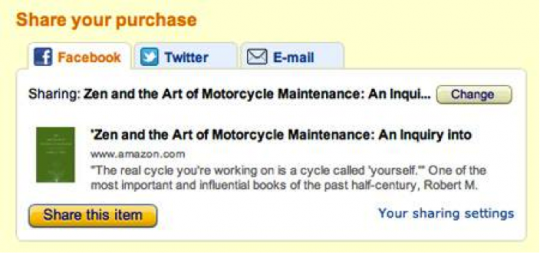 Image from brianmayer.com. The bottom line is this. You want the customer to have confidence in their decision. You want them to congratulate themselves on their intelligence at making this choice. Anything you can do to make them feel good after the sale will prevent returns and exchanges. Often, we as marketers focus on the front end of sales — getting the customers, persuading the customers, coaxing the customers, and funneling them into conversions. Once that happens, we do a happy dance. Wait a sec. The game’s not over after the decision has been made. You’ve got to continue to pamper the customer until they are entirely satisfied. This continues through the purchase and the period of potential buyer’s remorse.
Image from brianmayer.com. The bottom line is this. You want the customer to have confidence in their decision. You want them to congratulate themselves on their intelligence at making this choice. Anything you can do to make them feel good after the sale will prevent returns and exchanges. Often, we as marketers focus on the front end of sales — getting the customers, persuading the customers, coaxing the customers, and funneling them into conversions. Once that happens, we do a happy dance. Wait a sec. The game’s not over after the decision has been made. You’ve got to continue to pamper the customer until they are entirely satisfied. This continues through the purchase and the period of potential buyer’s remorse.
Conclusion
Adapting to a customer’s decision making process is part of the genius of conversion rate optimization. If you know how they come to a decision, you can help to influence that decision-making process in your favor. Keep in mind these four facts about decision making.
- Customers are only considering a few options. Make sure your option is one of those.
- Customers will reject data that conflicts with their decision. Use emotional arguments to persuade them otherwise.
- Customers make emotional decisions. Influence these emotions to help them move easily towards a conversion.
- Customers crave post-purchase confidence. Affirm them in their decision.
How do you help customers make decisions?
